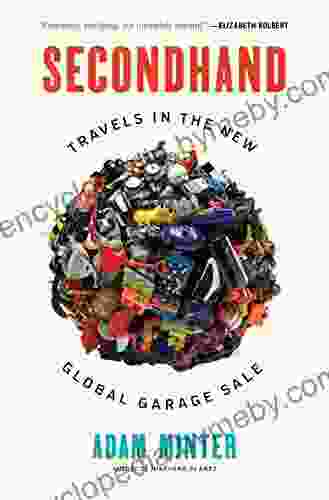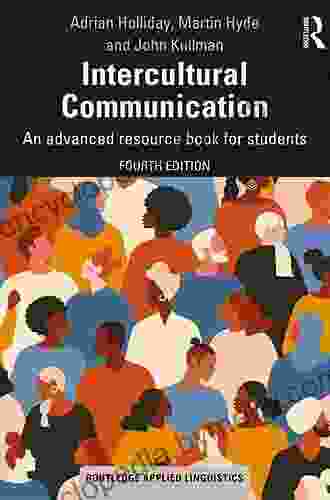Exploring the Crossroads of Cultures: An In-Depth Look at Intercultural Communication

The world we live in is an increasingly interconnected and diverse place. People from all walks of life are interacting with each other more frequently than ever before, and it is essential to have the skills to communicate effectively across cultural boundaries.
4 out of 5
| Language | : | English |
| File size | : | 3992 KB |
| Text-to-Speech | : | Enabled |
| Screen Reader | : | Supported |
| Enhanced typesetting | : | Enabled |
| Word Wise | : | Enabled |
| Print length | : | 319 pages |
Intercultural communication is the study of how people from different cultures communicate with each other. It is a complex and fascinating field that draws on a variety of disciplines, including anthropology, sociology, linguistics, and psychology.
In this book, we will explore the key concepts of intercultural communication, including:
- Cultural identity
- Cultural values
- Cultural norms
- Communication styles
- Nonverbal communication
We will also discuss the challenges of intercultural communication and offer practical tips for communicating effectively across cultures.
Cultural Identity
Our cultural identity is shaped by a variety of factors, including our family, our community, our education, and our experiences. Our cultural identity influences the way we see the world, the way we communicate, and the way we interact with others.
When we interact with people from other cultures, it is important to be aware of our own cultural identity and how it may affect our communication. We also need to be aware of the cultural identity of the other person and how it may affect their communication.
Cultural Values
Cultural values are the beliefs and principles that are shared by members of a particular culture. Cultural values influence the way people think, feel, and behave.
When we communicate with people from other cultures, it is important to be aware of their cultural values and how they may differ from our own. For example, in some cultures, it is important to be direct and assertive, while in other cultures, it is more important to be indirect and respectful.
Cultural Norms
Cultural norms are the unwritten rules that govern behavior within a particular culture. Cultural norms include things like how people greet each other, how they eat, and how they dress.
When we interact with people from other cultures, it is important to be aware of their cultural norms and to behave accordingly. For example, in some cultures, it is considered rude to make eye contact with strangers, while in other cultures, it is considered rude to not make eye contact.
Communication Styles
Communication styles vary from culture to culture. Some cultures are more direct and explicit in their communication, while other cultures are more indirect and implicit.
When we communicate with people from other cultures, it is important to be aware of their communication style and to adjust our own style accordingly. For example, if we are communicating with someone from a direct culture, we need to be clear and concise in our communication. If we are communicating with someone from an indirect culture, we need to be more subtle and indirect in our communication.
Nonverbal Communication
Nonverbal communication is the communication of information through body language, facial expressions, and eye contact. Nonverbal communication can be just as important as verbal communication, and it can sometimes convey more information.
When we communicate with people from other cultures, it is important to be aware of their nonverbal communication cues and to interpret them correctly. For example, in some cultures, it is considered rude to make eye contact, while in other cultures, it is considered rude to not make eye contact.
Challenges of Intercultural Communication
There are a number of challenges that can arise in intercultural communication. Some of these challenges include:
- Language barriers
- Cultural differences
- Stereotypes and prejudices
- Misunderstandings
- Conflict
It is important to be aware of these challenges and to develop strategies for overcoming them. With careful planning and preparation, it is possible to communicate effectively across cultural boundaries and build strong relationships with people from all over the world.
Tips for Communicating Effectively Across Cultures
Here are a few tips for communicating effectively across cultures:
- Be aware of your own cultural identity and how it may affect your communication.
- Be aware of the cultural identity of the other person and how it may affect their communication.
- Be respectful of cultural differences.
- Be patient and understanding.
- Be willing to learn about other cultures.
- Be open to new experiences.
- Be flexible and adaptable.
- Be willing to compromise.
By following these tips, you can increase your chances of communicating effectively across cultures and building strong relationships with people from all over the world.
Intercultural communication is a complex and fascinating field that is becoming increasingly important in today's globalized world. By understanding the key concepts of intercultural communication and by developing strategies for overcoming the challenges that can arise, you can communicate effectively across cultural boundaries and build strong relationships with people from all over the world.
This book is a comprehensive guide to intercultural communication. It provides a wealth of insights, practical tips, and case studies to help you communicate effectively across cultures. Whether you are a student, a businessperson, or a traveler, this book will help you to understand the challenges and rewards of intercultural communication.
Free Download your copy of To Intercultural Communication: Interdisciplinary Communication today and start your journey to becoming a more effective communicator across cultures.
4 out of 5
| Language | : | English |
| File size | : | 3992 KB |
| Text-to-Speech | : | Enabled |
| Screen Reader | : | Supported |
| Enhanced typesetting | : | Enabled |
| Word Wise | : | Enabled |
| Print length | : | 319 pages |
Do you want to contribute by writing guest posts on this blog?
Please contact us and send us a resume of previous articles that you have written.
 Book
Book Novel
Novel Page
Page Chapter
Chapter Text
Text Story
Story Genre
Genre Reader
Reader Library
Library Paperback
Paperback E-book
E-book Magazine
Magazine Newspaper
Newspaper Paragraph
Paragraph Sentence
Sentence Bookmark
Bookmark Shelf
Shelf Glossary
Glossary Bibliography
Bibliography Foreword
Foreword Preface
Preface Synopsis
Synopsis Annotation
Annotation Footnote
Footnote Manuscript
Manuscript Scroll
Scroll Codex
Codex Tome
Tome Bestseller
Bestseller Classics
Classics Library card
Library card Narrative
Narrative Biography
Biography Autobiography
Autobiography Memoir
Memoir Reference
Reference Encyclopedia
Encyclopedia Aaron Cohen
Aaron Cohen Elizabeth Gardner
Elizabeth Gardner Jean Reidy
Jean ReidyA G
 Lolita Chakrabarti
Lolita Chakrabarti Rochelle Knight
Rochelle Knight Adam Barkman
Adam Barkman Ida Pfeiffer
Ida Pfeiffer Caren Mcnelly Mccormack
Caren Mcnelly Mccormack Abby Colich
Abby Colich Dounya Awada
Dounya Awada Adam Abraham
Adam Abraham Aaron Nannini
Aaron Nannini Aaron Spencer Fogleman
Aaron Spencer Fogleman Aaron Bobrow Strain
Aaron Bobrow Strain Ada Calhoun
Ada Calhoun Adam Mayers
Adam Mayers Seanan Mcguire
Seanan Mcguire Adam Clarke
Adam Clarke Adam Gidwitz
Adam Gidwitz
Light bulbAdvertise smarter! Our strategic ad space ensures maximum exposure. Reserve your spot today!

 Shannon SimmonsPipestone: A Survivor's Journey Through the Dark Legacy of Indian Boarding...
Shannon SimmonsPipestone: A Survivor's Journey Through the Dark Legacy of Indian Boarding... Jonathan FranzenFollow ·2.5k
Jonathan FranzenFollow ·2.5k Holden BellFollow ·6.3k
Holden BellFollow ·6.3k Tyrone PowellFollow ·3.9k
Tyrone PowellFollow ·3.9k W. Somerset MaughamFollow ·18.8k
W. Somerset MaughamFollow ·18.8k Chinua AchebeFollow ·3.5k
Chinua AchebeFollow ·3.5k Jesus MitchellFollow ·9.4k
Jesus MitchellFollow ·9.4k Alexander BlairFollow ·8k
Alexander BlairFollow ·8k Andres CarterFollow ·11.8k
Andres CarterFollow ·11.8k

 Timothy Ward
Timothy WardFearless Painting for True Beginners: Learn to Create...
Unlock the Joy of...

 Fernando Pessoa
Fernando PessoaProven 12-Step Program for Financial Peace of Mind:...
Are you struggling with...

 Chinua Achebe
Chinua AchebeLayers Colors Desire: Layers Colors Thoughts Mystery
A Literary Labyrinth...

 Fernando Bell
Fernando BellUnearth Hidden Treasures: Journey Through "Secondhand...
Prepare to embark on an extraordinary...

 Caleb Carter
Caleb CarterSymbolic Messages Garage Sale Mysteries: Unveiling the...
Welcome to the extraordinary world of the...

 Nikolai Gogol
Nikolai GogolTravels in the Billion Dollar Trash Trade: Uncovering the...
Ỡ In his...
4 out of 5
| Language | : | English |
| File size | : | 3992 KB |
| Text-to-Speech | : | Enabled |
| Screen Reader | : | Supported |
| Enhanced typesetting | : | Enabled |
| Word Wise | : | Enabled |
| Print length | : | 319 pages |










